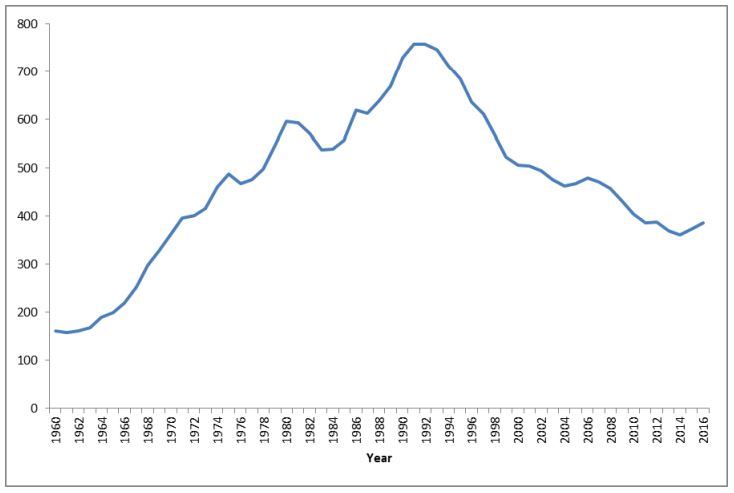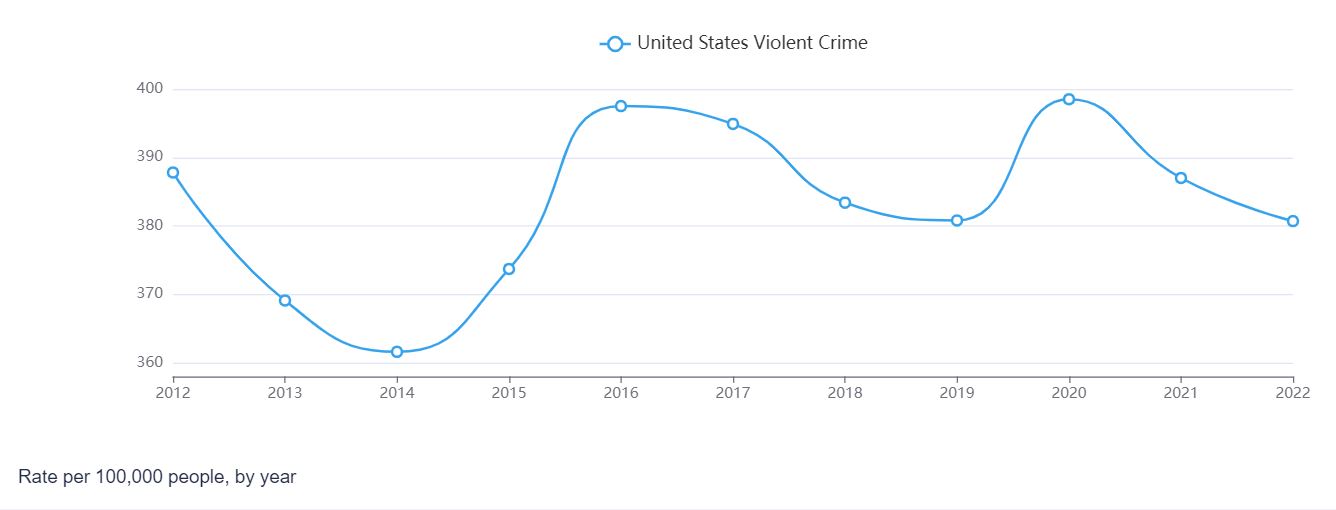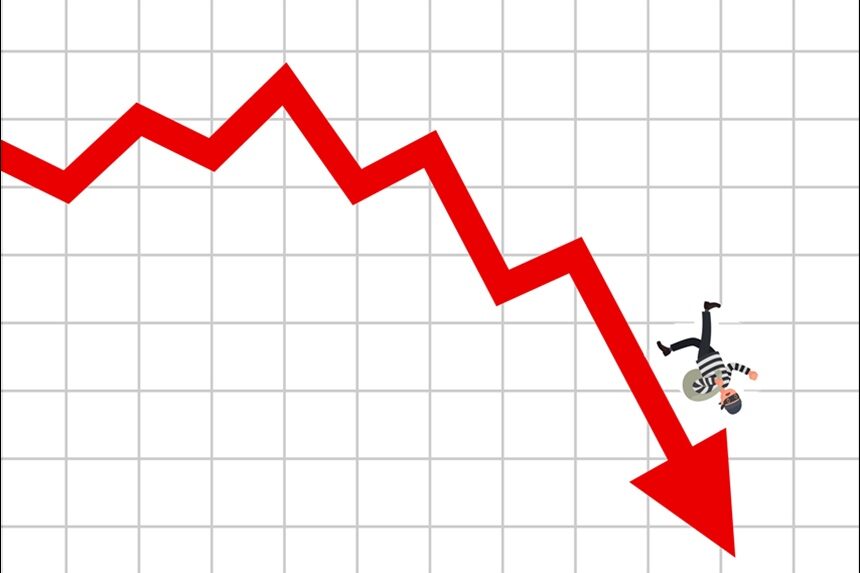The national crime rate is down.
This news is interesting enough by itself, but there three more surprising stories behind it.
The Declining Crime Rate Has Broken Records
The violent crime rate reached a 50-year low in 2023, according to a report from the Council on Criminal Justice. The number of murders in America fell by over 12 percent — the largest decline in our history — according to AH Datalytics. Our murder rate is now lower than it was in the 1970s, ’80s, and ’90s.
Most People Don’t Know Crime Is Down
In fact, they think the exact opposite. A Gallup poll from November 2023 found 77 percent of Americans believed there was more crime in the country than the year before. And 63 percent felt America had a “very serious” or “extremely serious” crime problem, the highest percentage recorded since 2000.
These beliefs are understandable when you consider what many, older Americans have grown up with. A crime wave began in the ’60s, which was attributed to the sharp increase in urban populations, societal unrest arising from civil rights and anti-war movements, and the spread of illegal drug use. Baby Boomers lived with an almost-constantly growing rate of violent crime from the 1960s up to the 1990s.

Crime statistics continued to grow until reaching a peak in 1991. The crime rate then fell until 2019 and the beginning of the Covid epidemic when crime suddenly increased.
In fact, the pandemic made 2020 one of America’s most dangerous years. Some of the reasons, according to the New York Times, were that police officers cut back on their personal contact with members of their community and had to deal with staff shortages, schools shut downs put teens out on the streets, and social service programs that reduced violence had to scale back. Then, in May of 2020, the killing of George Floyd raised mistrust in the police; some people took the law into their own hands.
FBI statistics from those years show a 30 percent increase in the number of murders, while other violent crime rose 5 percent. At the time, the resurgence of crime received broad media attention. The decline that followed the end of Covid drew less notice or was ignored altogether in favor of a more lurid narrative.
So, if you ask an average American who hasn’t been reading crime statistics if the rate of crime is rising or falling, they could perceive that it’s going up.
Why Did Crime Drop?
In 2015, The Brennan Center for Justice published a report titled “What Caused the Crime Decline?” that examined several factors that could play a part in the declining crime rate in the 1990s.

They noted financial factors: Unemployment and inflation were low, which reduced property crime. Increases in per capita income produced a 5 to 10 percent decrease of crime over the decade.
Another factor was a maturing population. In the 1990s, a large number of Americans grew out of the 15- to 29-year-old age range, which are crime-prone years.
Also playing a potential role in crime reduction was the elimination of lead from gasoline twenty years earlier. Exposure to lead has been linked to children’s lower scores on IQ tests, as well as cognitive and behavioral problems and aggressive behavior. The first generation to live without high lead exposure entered their crime-prone years in the 1990s, which possibly contributed to the lower crime level.
Meanwhile, some law enforcement agencies were taking a more analytical approach to decreasing crime. In 1994, New York City police introduced CompStat, a computer system that gathered critical information about crime to enable a more effective police response. It helped administrators identify critical areas, plan deployments, and assess results. New York’s City Transit Police claimed it helped them reduce subway crime, dropping gang robberies from 1,200 a year to 12. Crime in New York dropped noticeably after CompStat was installed, but there has since been debate on how much of a role CompStat played.
One fact that may come as a surprise is what made a minimal contribution to the lowered crime rate: incarceration.
For years, politicians have promoted longer jail sentences as a way to “get tougher” with criminals and deter them from criminal enterprise. But studies have shown that increasing prison sentences that are already long has little effect in discouraging criminals. Furthermore, raising the imprisonment rate seems to lower prison’s effectiveness in reducing crime. In “Five Things About Deterrence,” the National Institute of Justice says the prospect of being sent to prison isn’t a strong discouragement to a criminal. And neither is increasing the length of imprisonment or threatening the death penalty.
Moreover, the report points out criminal behavior declines sharply once prisoners pass beyond their 35th year. Prison terms that stretch well into a convict’s 40s and 50s might meet society’s need for punishment but they don’t lead to fewer future crimes.
The most powerful deterrent is the certainty that one will be caught and punished.
Last fall, the Guggenheim Foundation sponsored a study that forecasted crime rates into 2024 and beyond. The researchers predicted “very modest increases” in violent crime, which would plateau in 2025. Meanwhile, property crime would continue dropping.
The study also concluded that the current move to “decarcerate” criminals will cut the prison population by 20 percent and, unexpectedly perhaps, result in no significant increase in the crime rate.
Whatever the reason — reduced lead levels, more effective policing, or low unemployment — we can all agree that less crime is good news.
Become a Saturday Evening Post member and enjoy unlimited access. Subscribe now




Comments
Crime is being ignored. What used to be crimes have been reduced and/or eliminated. Drugs crimes eliminated by legislation. Larceny crimes likewise. No bail states have created a revolving crime door. What are the appearance ticket / failed to appear bench warrant stats?
The 2 self-important “experts” listed above, are typical of a wave of doubting , conspiracy riddled persons that will only believe in what they believe. No other source is tangible.
Your article is false. Period. While I am unsure where you get your “facts” the truth is they’re fake and you need to check them. You disregard all these illegal immigrants crossing into our country. Is that not a crime wave? You ignore the fact that dangerous criminals are being arrested but released under zero or low bail policies by District Attorneys and Their cronies who refuse to prosecute them. Simply put, your article is nothing but lies and outright full of sh*t. You really should be ashamed for misinforming your readers.